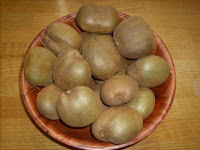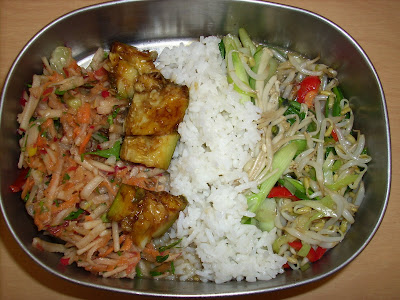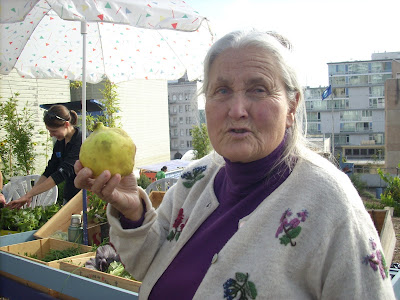-- Oxfam Grow Campaign (http://www.oxfamamerica.org/campaigns/food-justice)
 As part of this month’s Food Justice conference in Oakland, I attended Oxfam's Hunger Banquet: An Interfaith Call to Action to “experience the inequities of food resources in the Bay Area.” This event was hosted by East Bay Jewish Community Relations Council, First Unitarian Church of Oakland and California Food & Justice Coalition. When I checked in, I learned that I would assume the identity of a high-income person and was promptly escorted to be seated with other guests assuming high-income identities.
As part of this month’s Food Justice conference in Oakland, I attended Oxfam's Hunger Banquet: An Interfaith Call to Action to “experience the inequities of food resources in the Bay Area.” This event was hosted by East Bay Jewish Community Relations Council, First Unitarian Church of Oakland and California Food & Justice Coalition. When I checked in, I learned that I would assume the identity of a high-income person and was promptly escorted to be seated with other guests assuming high-income identities. 
• ¼ of all children suffer hunger
• Malnutrition and obesity are leading causes of death
• Two-thirds of income is concentrated in the wealthiest 1% of our population
• Many live a paycheck or illness away from hunger
She continued, saying there should be a human right to food. Everyone has the same basic needs, only our circumstances are different. The Great Recession has pushed many to lower-income brackets.
In the Bay Area, we see the following income distribution and household characteristics:
27% are high-income: >$100K/yr for family of 3; many food choices; access to the best medical care and nutrition information; it’s a given that children attend school; comfortable home and security; access to everything needed
50% are middle-income: $55K-$100K/yr for family of 3; lost paycheck/illness may throw them into poverty; some savings
23% are low-income: <$55K for family of 3; everyday is a struggle to meet basic needs—work, food, home; frequently hungry; lack access to healthy foods, often forced to decide between healthy food and rent/utilities
Anne asked some guests to read their character tickets. I learned that I made partner in my law firm and earned a bonus! (I told Anne that I would be happy to donate my bonus to share the wealth!) Other guests were not so fortunate, with many facing challenges like accidents, natural disasters, sudden illness, death of a family breadwinner, unemployment, etc. so they joined the low-income guests . . . seated on the floor.
This reminder of how precarious life is . . . so we’re all vulnerable to poverty and homelessness. The 1% could easily join the 99%, so it’s really in our best interests that we all look after one another. I remember Finn telling us, as new volunteers last year, about the displacement of homeless persons who formerly occupied our site before we grew The Free Farm. Now the homeless are fenced out except for our volunteer days when we’re open to everyone. Saint Paulus Church, which has been graciously allowing us to use their space, receives offers to sell . . . so The Free Farm could end up like our homeless predecessors and Hayes Valley Farm (http://thefreefarm.blogspot.com/2011/03/si-se-puede-yes-it-can-be-done.html)?
Before losing our appetite, the food came out . . . 


Since I was role-playing a high-income guest, I had the luxury of asking whether the chicken was free of hormones and antibiotics. As vegetarian, I actually offered my chicken to the middle-income and low-income guests. As a nutrition educator, I found the high-income meal lacking grains; the middle-income meal lacking veggies (remember, tomato is a fruit) and certain essential amino acids (grains are low in lysine and isoleucine, so vegetarians combine them with legumes or milk/eggs during the course of a day); the low-income meal also lacking in veggies (though the peanut butter sandwich was a good legume+grain protein combo).
In exchange for our free lunch, we were asked to reflect: What does the Hunger Banquet represent in the real world, and what can be done to change things for a more fair distribution of resources?
Since I was a tax advisor who actually worked on behalf of the 1% for several years, I’ve seen how tax policy motivates human behavior to redistribute resources: offer deductions and the 1% will give to charity and offer tax-qualified employee benefit plans! Alternatively, melancholy Scandinavians pay relatively high taxes to finance a cradle-to-grave welfare system so they seem to collectively enjoy a decent quality of life. Unfortunately, while taxes are as certain as death, I often get the MEGO (My Eyes Glaze Over) response whenever I mention taxes . . . oops, guess I better stop here or I’ll lose blog readers soon!
Anyway, our banquet ended with a Call to Action:
• Advocacy for SNAP funding: http://www.fightingpovertywithfaith.com/
• Volunteer at a local Food Bank: Suzan Bateson of Alameda County Community Food Bank http://www.accfb.org/ told us that her agency serves 1 out of 6 residents, and gave out orange rubber “Hope Not Hunger” bracelets
• Volunteer at a local Garden: Barbara Finnin of City Slicker Farms http://www.cityslickerfarms.org/ talked about turning vacant lots to backyard kitchen gardens
For San Francisco, I propose the following Call to Action sites (and I have volunteered with each):
• The Free Farm (of course!)
• Community Living Campaign OMI Food Network: http://sfcommunityliving.org/omi.html
• Meals on Wheels SF: http://www.mowsf.org/
• Project Open Hand: http://www.openhand.org/
• SF Food Bank: http://www.sffoodbank.org/
Hope to see you at The Free Farm, and we can grow veggies to feed the middle- and low-income classes at the next Hunger Banquet!
Public Service Announcements:
Film & Discussion: "DIVE! Living off America's Waste"
Koret Auditorium, SF Main Library, 100 Larkin St., (at Grove), SF
Every year in America we throw away 96 billion pounds of food. That's 263 million pounds a day. 11 million pounds an hour. 3,000 pounds a second. Inspired by a curiosity about society's careless habit of sending food straight to landfills, the multi award-winning documentary DIVE! follows filmmaker Jeremy Seifert and friends as they dumpster dive in the back alleys and gated garbage supermarket receptacles. In the process, they salvage thousands of dollars worth of good, edible food - resulting in an eye-opening documentary that is equal parts entertainment, guerilla journalism and call to action. DIVE! has garnered critical praise while raising important questions about hunger and waste in society. This is Seifert's first film and has been warmly received by audiences across the country, winning nineteen festivals thus far, including the Boulder International, Sedona International, DC Independent, and the Green Film Festival in Seoul. Discussion following the film. This is a Stegner Environmental Center, San Francisco Green Film Festival and Green Stacks Program.
http://www.sfpl.org/index.php?pg=1007345701
Wed., Nov. 30, 2011, 6:15-8:45 pm
How to Turn the Food Movement into a Force for Social Transformation
Hotel Shattuck Plaza, 2086 Allston Way, Berkeley
Each Rooted and Rising event begins with an intergenerational dialogue on a particular topic that will transpire between a youth leader or activist and a seasoned activist or professional. After the dialogue, we facilitate a Solutions Salon, which encourages participants to utilize each other as resources. Each will be encouraged to share with the group what they are currently working on and/or what challenges they face on a personal or professional level that pertains to the topic at hand, with opportunity to give and receive feedback and resources. In Convergence in Diversity: How to Turn the Food Movement into a Force for Social Transformation, we bring prominent figures and youth visionaries from different sectors of the food movement together to discuss ways that we can fortify one another with ideas, resources and strategies. Be sure to join us at this very special Rooted and Rising. Speakers Include: Eric Holt-Giménez, Executive Director of Food First; Hai Vo, Brower Youth Award Winner 2009; Dana Harvey, Executive Director of Mandela Marketplace; Bettina Ring, Executive Director of Bay Area Open Space Council; Tania Pulido, Brower Youth Award Winner 2011.
http://convergenceindiversity.eventbrite.com/
Thurs., Dec. 1, 2011, 7-9 pm
City Chicks, Book Event with Author Patricia Foreman
Ecology Center Store, 2530 San Pablo Ave., Berkeley.
Meet author Patricia Foreman for a discussion on chickens and how they can help city-dwellers live more sustainably. Pat's new book, "City Chicks", describes in detail how to develop your own "Chicken Have More Plan" for increased self-sufficiency. Learn how to create hyper-fertile soils to produce nutritious food from your garden. Instead of using petroleum-based products, chickens will help produce organic fertilizer and compost. They can turn yard waste into garden soil and can be employed to control weeds and pests without toxic chemicals. Chickens also perform community and civic service by diverting yard and food biomass waste from municipal trash collection.
http://ecologycenter.org/
Sun., Dec. 4, 2011, 5:30-9 pm
Label GMOs for 2012 CA Ballot Campaign Volunteer Welcome
5:30 pm Non-GMO potluck; 7 pm Educational program covering basic facts and talking points around GMOs, tips for gathering signatures.
RSVP: SF Regional Co-Coordinator Liz Kroboth at LabelGMOsSF@gmail.com
This grassroots movement of concerned consumers, farmers, businesses, food safety experts all around California are working to put an initiative on the CA 2012 ballot that would require labeling of genetically modified foods (GMOs). Learn more at http://www.labelgmos.org/
http://www.facebook.com/event.php?eid=192057214212062
Tues., Dec. 6, 2011, 6-7:30 pm
Cultivating Food Justice: Race, Class and Sustainability
UC Berkeley, Berkeley 94720
Reception: 5:00-6:00 pm, 2nd Floor Lobby, Wurster
Lecture: 6:00-7:30 pm, Wurster Hall 112
Discussion featuring book editors Alison Hope Alkon and Julian Agyeman and chapter authors Eric Holt-Giminez, Julie Guthman, Laura-Anne Minkoff-Zern, A. Breeze Harper and Sandy Brown.
http://cultivatingfoodjustice.com/wordpress/?page_id=34




























 Stanley recruited Andrew & Kim from 2011 Getup class
Stanley recruited Andrew & Kim from 2011 Getup class























